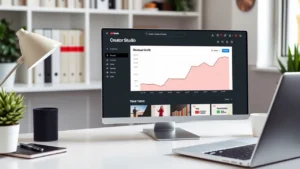Why Avoiding Common YouTube Mistakes Matters?
You’ve probably heard the phrase, “Success leaves clues.” Well, so does failure—especially on YouTube. The platform is a goldmine of opportunity for creators, but it’s also littered with pitfalls that can derail even the most passionate content makers. If you’re serious about growing your channel, avoiding common YouTube mistakes isn’t just optional—it’s essential.

Let me paint a picture for you. Imagine spending hours brainstorming ideas, filming, editing, and uploading videos only to see them gather dust in the abyss of YouTube’s algorithm. Frustrating, right? That’s exactly what happens when you overlook critical elements like SEO, engagement, or video quality. For instance, take Sarah, a lifestyle vlogger who started her channel with high hopes. She uploaded consistently but ignored basic optimization techniques like keyword research and proper tagging. After six months, she had fewer than 50 subscribers. It wasn’t until she revamped her strategy by addressing these mistakes that her channel began to grow exponentially.
The truth is, YouTube rewards creators who play by its rules. According to a 2023 study, channels that optimize their content for searchability and viewer retention tend to grow 3x faster than those that don’t. But here’s the kicker: many new creators aren’t aware of these “rules” because they’re too busy focusing on creativity alone. While creativity is vital, it needs to be paired with strategy if you want to stand out in a sea of over 50 million active channels.
So why does avoiding mistakes matter so much? Because every error costs you time, effort, and potential growth. Whether it’s neglecting analytics, failing to engage with your audience, or simply not understanding how the algorithm works, each misstep chips away at your chances of success. In this post, we’ll dive deep into the top 10 mistakes holding back aspiring YouTubers—and more importantly, show you how to fix them. Trust me; once you know what to look out for, you’ll be unstoppable.
01: Ignoring YouTube SEO Basics
If you think SEO is just for websites, think again. On YouTube, SEO is the backbone of discoverability. Without it, your videos might as well be invisible. Yet, countless creators ignore this crucial step, leaving their hard work buried under layers of better-optimized content.
What Exactly Is YouTube SEO?
YouTube SEO involves optimizing your videos so they rank higher in search results and suggested videos. This includes using relevant keywords in your title, description, tags, and even captions. Think of it as giving YouTube clues about what your video is about. For example, if you’re creating a tutorial on “how to bake sourdough bread,” including phrases like “easy sourdough recipe” or “beginner sourdough tips” helps YouTube understand your content and recommend it to users searching for those terms.
Examples of Poor SEO Practices
Let’s talk about John, a tech reviewer who made a killer unboxing video for a new smartphone. He titled it “Cool Phone Review!” Sounds catchy, right? Wrong. His vague title didn’t include any keywords people were actually searching for, like “iPhone 14 Pro review” or “best features of iPhone 14.” As a result, his video got lost among thousands of other reviews. Meanwhile, another creator used precise keywords and ended up ranking on page one of YouTube search results.
How to Optimize Your Videos
Here’s where things get actionable. Start by researching keywords using tools like TubeBuddy or VidIQ. These platforms analyze trending searches and suggest high-performing keywords. Once you have your list, incorporate them naturally into your title, description, and tags. Don’t stuff keywords unnaturally—YouTube’s algorithm is smart enough to detect spammy behavior.
For descriptions, aim for at least 200 words. Include timestamps, links to related content, and calls-to-action (CTAs) like “Subscribe for more tutorials!” Captions are another underrated tool. Adding accurate subtitles not only improves accessibility but also boosts SEO since YouTube scans them for context.
Case Study: Success Through SEO
Take Alex, a fitness coach who struggled to gain traction despite posting daily workout videos. After learning about SEO, he reworked his titles to include phrases like “home workouts no equipment” and “quick morning exercises.” Within weeks, his views skyrocketed, and he gained over 10,000 subscribers in two months. Moral of the story? SEO isn’t optional—it’s mandatory.
02: Neglecting Thumbnails and Titles
Let’s face it—your thumbnail and title are the first things viewers see when scrolling through YouTube. If they’re not compelling, you’ve already lost half the battle. Yet, so many creators neglect these crucial elements, opting for bland or generic visuals that fail to grab attention.
Why Thumbnails Matter More Than You Think
Think of your thumbnail as the cover of a book. Would you pick up a novel with a blurry, uninteresting cover? Probably not. The same logic applies to YouTube. A well-designed thumbnail can increase your click-through rate (CTR) significantly, which in turn signals to YouTube that your content is worth promoting.
Take this funny story for example: Emily, a travel vlogger, once used a poorly cropped photo of herself standing in front of the Eiffel Tower as her thumbnail. It was grainy, poorly lit, and didn’t convey any emotion. Her video barely got 100 views. But when she redesigned her thumbnail with bold text (“Top 5 Hidden Gems in Paris!”), vibrant colors, and a close-up shot of her smiling face, her CTR doubled overnight. Suddenly, people were clicking—and staying.
Best Practices for Creating Eye-Catching Thumbnails
Here’s how to craft thumbnails that pop:
Use High-Quality Images : Blurry or pixelated thumbnails scream amateur. Invest in a good camera or use stock photos if necessary.
Incorporate Bold Text : Keep it short and impactful. Phrases like “You Won’t Believe This!” or “#1 Travel Hack” work wonders.
Leverage Color Contrast : Bright colors against dark backgrounds (or vice versa) make your thumbnail stand out.
Show Emotion : Faces with clear expressions—whether happy, surprised, or excited—draw viewers in.
Tools like Canva, Photoshop, or even free apps like Snapseed can help you create professional-looking thumbnails without breaking the bank.
The Role of Titles in Driving Clicks
Your title should complement your thumbnail by sparking curiosity. Avoid vague titles like “My Day in NYC” and opt for something more specific, such as “NYC Secrets: Exploring Underground Tunnels.” Numbers and power words (“Ultimate,” “Secrets,” “Proven”) also boost engagement.
For instance, Jake, a gaming YouTuber, saw his views triple after changing his title from “Fortnite Gameplay” to “How I Won $10K Playing Fortnite – Tips & Tricks.” Specificity sells.
03: Inconsistent Upload Schedule
Consistency isn’t just a buzzword—it’s the lifeblood of channel growth. When you upload sporadically, you confuse both your audience and YouTube’s algorithm. This inconsistency can lead to lower retention rates, fewer recommendations, and ultimately, stagnation.
How Consistency Builds Trust
Imagine subscribing to a channel only to find new videos months apart. Frustrating, right? Regular uploads signal reliability, encouraging viewers to return. Plus, YouTube favors channels that post consistently because it keeps users on the platform longer.
Consider Lisa, a beauty influencer who struggled to grow her channel despite creating high-quality tutorials. Her breakthrough came when she committed to uploading every Wednesday at 6 PM. Within three months, her subscriber count jumped from 500 to 10,000. Why? Because her audience knew exactly when to expect fresh content.
Creating a Realistic Upload Calendar
Start by assessing your capacity. If daily uploads feel overwhelming, aim for weekly or bi-weekly posts. Use tools like Google Calendar or Trello to plan ahead. Batch filming multiple videos in one day can save time and ensure consistency.
Automation services can also help streamline scheduling. For example, platforms like Buffer or Hootsuite allow you to schedule uploads in advance, ensuring you never miss a deadline.
Real-Life Example: The Power of Routine
Take Mark, a fitness coach who went from zero to 50,000 subscribers in under a year. His secret? A strict Monday-Wednesday-Friday upload schedule. He even teased upcoming videos during live streams to build anticipation. By sticking to his routine, he built trust and loyalty among his audience.
04: Failing to Engage with Your Audience
Engagement is the heartbeat of any successful YouTube channel. Yet, many creators treat their audience as passive consumers rather than active participants. This lack of interaction can alienate viewers and stunt growth.
Why Engagement Matters
YouTube’s algorithm prioritizes videos with high engagement metrics like likes, comments, and shares. When viewers interact with your content, it signals value, prompting YouTube to recommend your videos to others.
A great example comes from Mike, a comedy sketch creator. Initially, he ignored comments, assuming they weren’t important. Then, he started responding to every comment—funny ones, constructive criticism, even trolls. To his surprise, his engagement skyrocketed. Viewers loved the personal touch, and his community grew rapidly.
Actionable Tips for Boosting Engagement
Ask Questions : End each video with a question like “What topic should I cover next?”
Host Polls : Use YouTube’s Community Tab or Instagram Stories to gather feedback.
Go Live : Live streams foster real-time interaction and deepen connections.
Respond to Comments : Show appreciation for supportive comments and address concerns professionally.
Storytime: Turning Haters Into Fans
One creator, Anna, received harsh criticism on a cooking video. Instead of ignoring it, she replied with humor: “Thanks for pointing that out! Next time, I’ll add extra seasoning—and maybe a dash of patience too!” Her witty response turned a negative comment into a viral moment, earning her thousands of new followers.
05: Overlooking Video Quality and Editing
Poor video or audio quality can ruin an otherwise stellar concept. Viewers have high standards, and subpar production values often lead to early drop-offs.
Common Mistakes in Video Production
Bad Lighting : Dark or uneven lighting makes videos hard to watch.
Low Audio Quality : Muffled or echoey audio distracts viewers.
Overly Long Intros : Viewers lose interest within seconds if intros drag on.
Tips for Improving Quality
Invest in affordable gear like ring lights, lapel mics, and tripods. For editing, use software like DaVinci Resolve or iMovie to polish your footage.
Case Study: Upgrading Equipment Pays Off
Tom, a tech reviewer, upgraded his microphone and saw a 40% increase in watch time. His crisp audio made tutorials easier to follow, boosting viewer satisfaction.
06: Not Understanding the YouTube Algorithm
The algorithm determines which videos get recommended. Misunderstanding it leads to missed opportunities.
Key Factors
Watch Time
Click-Through Rate (CTR)
Session Duration
Analogy
Think of the algorithm as a picky diner—it rewards content that keeps viewers engaged.
07: Skipping Proper Monetization Strategies
Monetization extends beyond ads. Diversify income through sponsorships, memberships, and affiliate marketing.
Example
Jane earned $10K/month via brand partnerships instead of relying solely on AdSense.
08: Underestimating the Power1 of Analytics
Analytics reveal what works and what doesn’t. Track metrics like retention and traffic sources.
09: Falling for “Get Rich Quick” Schemes
Avoid scams promising overnight success. Patience and consistency always win.
10: Conclusion
We’ve covered the top 10 common YouTube mistakes and how to fix them. From mastering SEO to engaging with your audience, these strategies will set you on the path to success. Ready to take your channel to the next level? Check out our blog for more tips and tricks!


